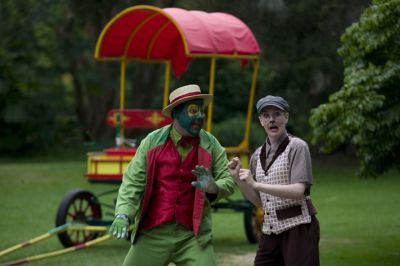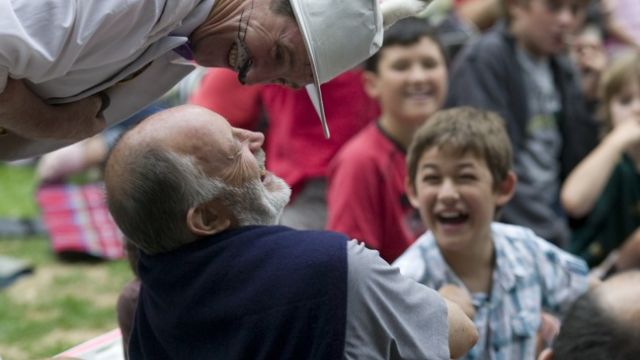Twenty Years as Head Chief Rabbit.
The Australian Shakespeare Company’s adaptation of Kenneth Grahame’s The Wind in the Willows has returned for another season in the Royal Botanic Gardens, Melbourne, where the show has been entertaining Melburnians for over a quarter of a century. The show is also playing at Sydney’s Botanic Gardens.
This summer also marks versatile acrobat, clown, character actor and musician Rosco Mathers 20th year playing the star role of Head Chief Rabbit. Rosco spoke to Stage Whispers Editor Neil Litchfield about his two decades with the show.
Neil Litchfield: As I understand it, a lot of your work involves engaging the kids in the audience.
Rosco Mathers:In the beginning the Head Chief Rabbit role was very much a people wrangling role, looking after the kids, making sure people travelled between one site and another, and making sure that people arrive and sit, and if kids run onto the stage, then Head Chief Rabbit needs to take control of that business, though it’s morphed a little more into character stuff, though he does still have those roles these days.
NL: So that involves enlisting all the kids as rabbits?
RM: At the very beginning the first thing I do is endow them with rabbit-like qualities – waggling their ears and wiggling their noses – and straight away we transform them into rabbits, and call them rabbits continually all the way through – so they stop being kids and they’re rabbits throughout the whole show.
NL: Do all kids engage easily, or do you have to work harder with some audiences?
RM: Occasionally you get kids who get very excitied, but generally there’s something in the show that will calm them down as well, or catch their interest. There’s a little bit of something there for all the children, and adults as well, because they sometimes get a little distracted too.
NL: Do you have a favourite moment or two of child audience response over the years?
 RM: Plenty. One that comes to mind is that at one moment the Head Chief Rabbit is arrested by the policeman, clamped with manacles and thrown into prison. That usually gets a bit of an ‘Aww!!’ from the audience, but one day as the policeman slammed the handcuffs on, a woman stood up at the back and said ‘Don’t you dare arrest my rabbit,’ in the loudest voice. I just thought, ‘I think I’ve done well this show for my team.’ She was very loud, and pointed at the policeman and told him not to do it.
RM: Plenty. One that comes to mind is that at one moment the Head Chief Rabbit is arrested by the policeman, clamped with manacles and thrown into prison. That usually gets a bit of an ‘Aww!!’ from the audience, but one day as the policeman slammed the handcuffs on, a woman stood up at the back and said ‘Don’t you dare arrest my rabbit,’ in the loudest voice. I just thought, ‘I think I’ve done well this show for my team.’ She was very loud, and pointed at the policeman and told him not to do it.
There’s another moment when the policeman arrests two or three of the rabbits, and they come to prison with me on stage. Usually there are only two or three, but it doesn’t actually stop a flood of children. Sometimes the show has to stop for a minute or so, while every kid thinks they are coming to prison as well, and suddenly there’s 40 kids on stage with us. That can be absolutely hilarious. You’ve got to run with that, you can’t stop the children from doing that. We’ve got lines that cover it as they all rush in, and eventually, once they all settle down, it actually becomes more fun the more of them there are. We’re not fazed by any of those things; if there’s five kids it works, if there’s 50 kids it also works very well. The actors have really good improvisation skills and are really good at covering when things change. Because I’ve done it for 20 years, on most occasions there’s not really much I’m not expecting.
NL: What changes have you brought to the Head Chief Rabbit over the years?
RM: The first few years we did it, the Head Chief Rabbit wasn’t really a character within the show so much as just wrangling the audience. I used to do a 20-minute juggling and magic show at the top, which wasn’t always particularly related to the storyline, but more to gain attention. Over the years that’s become less so, and the Head Chief Rabbit’s character has evolved. It’s got more of an arc now, rather than taking people from one spot to another. But over the years I’ve done acrobatics or magic, or juggling. I used to unicycle in to start the show, bits of circus – it varies – I’ve got a nice big bag of tricks. It just depends on how the director would like things to run.
And there’s the music as well. What’s happened alongside the Head Chief Rabbit becoming more of a character is that the Weasel has also become a foil to the Rabbit or vice versa, and those two characters now do the bulk of music to the show. The Weasel always needs to be a multi-instrumentalist. We’ve got a tremendous one this year who plays horns and trumpet and drums and sound effects. We’ve got a lot more sound effects and background noises and crunches and bangs and that kind of thing, and I guess I’ve been instrumental in making sure those things develop in the show.
NL: What makes this production such a perfect fit for the gardens, or is it vice versa?
RM: I think just the beauty of the Gardens, for starters. Before you even get there you’re not thinking of the show, you’re enjoying the sound of the wind in the trees, and the lovely lakes, and you’re really getting involved in the duck noises and all the sounds that are going on. Once people are sitting in that environment, when the animals appear it seems to all be quite natural for them to appear, so once the show gets going, I think what people recognize about Willows is the characters are so well drawn.
You can’t go past Mr Toad. He’s a four-year-old; he’s a crazy kind of a clown that everyone just recognizes straight away – the naughty, can’t-be-stopped sort of clown-child.
Then we have the authoritarian Mr Badger, who everyone recognizes through their parents or their teachers, of course Mole, who is a character who grows a lot through the show – very much a protagonist I think.
The young kids just love Mole. They just see her struggling against being shy and slow, then finally helping to save the day. She’s very courageous. Plus we have a little Portly in the show – she’s the Otter’s child, and the kids just love to see an 8, 9 or 10 year old child acting in the show. They’re just drawn to that.
And then there’s the parents and older people. We get quite a lot of couples and twenty-somethings who just turn up for a picnic, and I think it’s just the whole experience – the picnic, the sounds, the lake, the river, and a beautifully written story. I think Kenneth Graham’s story is already very funny, and the text is very good.
The other thing I think about Kenneth Grahame is that it’s not condescending. He uses big words and I think people get very involved in the language of the show. There’s a recognition that people have of the clowniness of the characters, too, that makes the text so enduring.
We’ve got a new set of actors this year. I’m the only one who’s come back who has done it before, so it’s all very fresh and new, and exciting, and I think that if people come down, they’d all have a lovely time.
NL: Are there any new actors who bring something particularly new and unique to the show?
RM: The Mole character is quite a bit younger than most of the other Mole actors, and therefore I’m noticing that she’s a bit more stringy and bouncy than some of the others, and it looks great that she’s so active. Mr Badger is very Stentorian this year – he’s a very big man, about 6 foot three or so, and that makes him very, very striking. And as I say, the gentleman who is playing the Weasel, Jim Dunlop, is a terrific multi-instrumentalist, and it’s exciting to play with somebody who plays so many instruments.
The Wind in the Willows plays at the Royal Botanic Gardens Melbourne until January 26, 2013 (enter through Gate F on Birdwood Avenue then follow the signs to the on‐site box office). Bookings: 03 8676 7511 or online at www.shakespeareaustralia.com.au
The Wind in the Willows also plays in Sydney, at the Royal Botanic Garden, until January 27 (enter via any gate and make your way to the Harbour side of the Main Pond). See Carol Wimmer’s Review. Bookings: 1300 122 344 www.shakespeareaustralia.com.au
More Reading
Subscribe to our E-Newsletter, buy our latest print edition or find a Performing Arts book at Book Nook.

